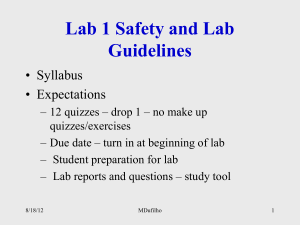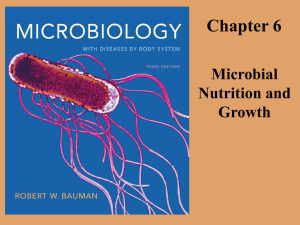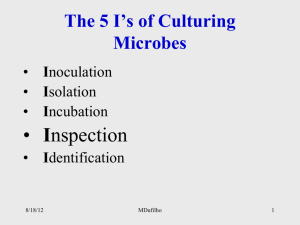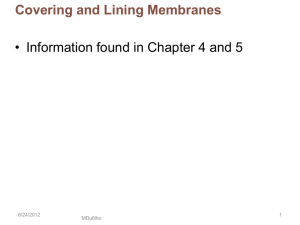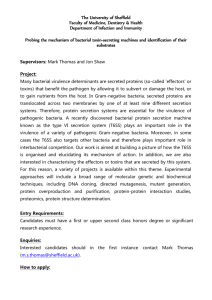Chap 11 Prokaryotes - Abbreviated Fall 2012
advertisement
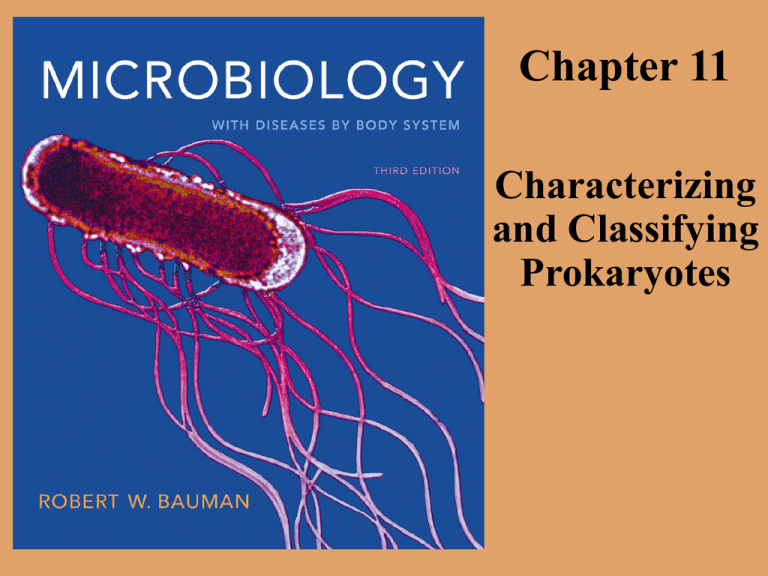
Chapter 11 Characterizing and Classifying Prokaryotes General Characteristics of Prokaryotic Organisms • Prokaryotes – Most diverse group of cellular microbes – Habitats – From Antarctic glaciers to thermal hot springs – From colons of animals to cytoplasm of other prokaryotes – From distilled water to supersaturated brine – From disinfectant solutions to basalt rocks – Only a few capable of colonizing humans and causing disease 10/1/11 MDufilho 2 Figure 11.1 Typical prokaryotic morphologies Coccus Spirillum Coccobacillus Spirochete Bacillus Pleomorphic Vibrio 10/1/11 MDufilho 3 General Characteristics of Prokaryotic Organisms • Reproduction of Prokaryotic Cells – All reproduce asexually – Three main methods – Binary fission (most common) – Snapping division – Budding 10/1/11 MDufilho 4 Figure 11.2 Binary fission Cell replicates its DNA. Cell wall Cytoplasmic membrane Replicated DNA Nucleoid The cytoplasmic membrane elongates, separating DNA molecules. Cross wall forms; membrane invaginates. Cross wall forms completely. Daughter cells may separate. 10/1/11 MDufilho 5 Figure 11.3 Snapping division-overview 10/1/11 MDufilho 6 Figure 11.4 Actinomycetes spores Spores 10/1/11 MDufilho 7 Figure 11.5 Budding DNA is replicated One daughter DNA molecule is moved into bud Young bud 10/1/11 MDufilho Daughter cell 8 Modern Prokaryotic Classification • Currently based on genetic relatedness of rRNA sequences • Three domains – Archaea – Bacteria – Eukarya 10/1/11 MDufilho 9 Survey of Bacteria • Low G+C Gram-Positive Bacteria – Clostridia – Rod-shaped, obligate anaerobes, toxin producing, endospore formers – Important in medicine and industry 10/1/11 MDufilho 10 Bacterial Diseases of the Digestive System • Bacterial Gastroenteritis: AntimicrobialAssociated Diarrhea – Signs and symptoms – Pseudomembranous colitis occurs in severe cases – Pathogen and virulence factors – Caused by Clostridium difficile – Antimicrobial use facilitates overgrowth of C. difficile – C. difficile produces two toxins – Pathogenesis 10/1/11 – Toxins mediate inflammation and pseudomembrane formation MDufilho 11 Figure 23.9 Pseudomembranous colitis 10/1/11 Lesions MDufilho 12 Bacterial Diseases of the Digestive System • Bacterial Gastroenteritis: AntimicrobialAssociated Diarrhea – Epidemiology – By-product of modern medicine – Any antimicrobial can trigger the disease – Diagnosis, treatment, and prevention – Diagnosis based on presence of bacterial toxin in stool – Treat with antimicrobials – Avoid unnecessary use of antimicrobials 10/1/11 MDufilho 13 Bacterial Diseases of the Skin and Wounds • Gas Gangrene – Signs and symptoms – Blackening of infected muscle and skin – Presence of gas bubbles – Pathogens and virulence factors – Caused by several Clostridium species – Bacterial endospores survive harsh conditions – Vegetative cells secrete 11 toxins 10/1/11 MDufilho 14 Bacterial Diseases of the Skin and Wounds • Gas Gangrene – Pathogenesis and epidemiology – Traumatic event must introduce endospores into dead tissue – Mortality rate exceeds 40% – Diagnosis, treatment, and prevention – Appearance is usually diagnostic – Rapid treatment is crucial – Surgical removal of dead tissue – Administration of antitoxin and penicillin – Prevent with proper cleaning of wounds 10/1/11 MDufilho 15 Survey of Bacteria • Low G+C Gram-Positive Bacteria – Low G+C bacilli and cocci – Bacillus–many common in soil – B. anthracis – cause of cutaneous and pulmonary anthrax – Listeria–contaminates milk and meat products– Listeria monocytogenes – Causes meningitis of immuno-compromised – pregnant, newborns, elderly – Organism can live within cells undetected by the immune system 10/1/11 MDufilho 16 Bacterial Diseases of the Skin and Wounds • Cutaneous Anthrax – Caused by Bacillus anthracis – Characterized by an eschar – Black, painless, ulcer – Treated with antimicrobial drugs – Prevention requires control of the disease in animals 10/1/11 MDufilho 17 Survey of Bacteria • Low G+C Gram-Positive Bacteria – Low G+C bacilli and cocci – Lactobacillus–grows in the body but rarely causes disease – Streptococcus and Enterococcus–cause numerous diseases 10/1/11 MDufilho 18 Bacterial Diseases of the Upper Respiratory System, Sinuses, and Ears • Streptococcal Respiratory Diseases – Signs and symptoms – Sore throat and difficulty swallowing – May progress to scarlet or rheumatic fever – Pathogen and virulence factors – Caused by group A streptococci (S. pyogenes) – Variety of virulence factors – M proteins, hyaluronic acid capsule, streptokinases, C5a peptidase, pyrogenic toxins, streptolysins 10/1/11 MDufilho 19 Streptococcal Pharyngitis (Strep Throat): pus pockets on tonsils Pus pockets on tonsils The reddened appearance and pus pockets of a throat with pharyngitis Bacterial Diseases of the Upper Respiratory System, Sinuses, and Ears • Streptococcal Respiratory Diseases – Pathogenesis – Occurs when normal microbiota are depleted, large inoculum is introduced, or adaptive immunity is impaired – Epidemiology – Spread via respiratory droplets – Occurs most often in winter and spring – Diagnosis, treatment, and prevention 10/1/11 – Often confused with viral pharyngitis – Penicillin is an effective treatment MDufilho 21 Bacterial Diseases of the Skin and Wounds • Necrotizing Fasciitis – Pathogen and virulence factors – Most cases caused by S. pyogenes – Various enzymes facilitate invasion of tissues – Exotoxin A and streptolysin S are also secreted – Pathogenesis and epidemiology – S. pyogenes enters through breaks in the skin – Usually spread person-to-person – Diagnosis, treatment, and prevention 10/1/11 – Early diagnosis is difficult because symptoms are nonspecific MDufilho 22 – Treat with clindamycin and penicillin Figure 19.6 Necrotizing fasciitis 10/1/11 MDufilho 23 Survey of Bacteria • Low G+C Gram-Positive Bacteria – Low G+C bacilli and cocci – Staphylococcus–one of the most common inhabitants of humans – S. aureus – Can cause food poisoning – produces 5 toxins – Endocarditis, styes, pneumonia, skin infections 10/1/11 MDufilho 24 Bacterial Diseases of the Skin and Wounds • Staphylococcal Scalded Skin Syndrome – Pathogen and virulence factors – Some Staphylococcus aureus strains – One or two different exfoliative toxins cause SSSS – Pathogenesis – No scarring because dermis is unaffected – Death is rare but may be due to secondary infections – Epidemiology – Disease occurs primarily in infants – Transmitted by person-to-person spread of bacteria 10/1/11 MDufilho 25 Figure 19.3 Staphylococcal scalded skin syndrome 10/1/11 MDufilho 26 Bacterial Diseases of the Skin and Wounds • Staphylococcal Scalded Skin Syndrome – Diagnosis, treatment, and prevention – Diagnosed by characteristic sloughing of skin – Treated by administration of antimicrobial drugs – Widespread presence of S. aureus makes prevention difficult 10/1/11 MDufilho 27 Bacterial Diseases of the Skin and Wounds • Impetigo (Pyoderma) and Erysipelas – Pathogens and virulence factors – Most cases are caused by S. aureus – Some cases are caused by Streptococcus pyogenes – Gram-positive coccus, arranged in chains – Virulence factors similar to those of S. aureus – M protein – Hyaluronic acid – Pyrogenic toxins 10/1/11 MDufilho 28 Figure 19.4 Impetigo 10/1/11 MDufilho 29 Figure 19.5 Erysipelas 10/1/11 MDufilho 30 Bacterial Diseases of the Skin and Wounds • Impetigo (Pyoderma) and Erysipelas – Pathogenesis – The bacteria invade where the skin is compromised – Epidemiology – Transmitted by person-to-person contact or via fomites – Impetigo occurs most in children – Erysipelas can also occur in the elderly 10/1/11 MDufilho 31 Bacterial Diseases of the Skin and Wounds • Impetigo (Pyoderma) and Erysipelas – Diagnosis, treatment, and prevention – The presence of vesicles is diagnostic for impetigo – Treat with penicillin and careful cleaning of infected areas – Prevent with proper hygiene and cleanliness 10/1/11 MDufilho 32 Survey of Bacteria • High G+C Gram-Positive Bacteria – Mycobacterium – Aerobic rods that sometimes form filaments – Slow growth partly due to mycolic acid in its cell walls – Mycobacterium tuberculosis - tuberculosis – Actinomycetes – Form branching filaments resembling fungi – Important genera include Actinomyces, Nocardia, Streptomyces 10/1/11 MDufilho 33 Survey of Bacteria • Gram-Negative Proteobacteria – Largest and most diverse group of bacteria – Many have extensions called prosthecae – Used for attachment and to increase surface area for nutrient absorption – Alphaproteobacteria – Pathogenic alphaproteobacteria – Rickettsia – Brucella 10/1/11 MDufilho 34 Bacterial Diseases of the Skin and Wounds • Rocky Mountain Spotted Fever – Signs and symptoms – Non-itchy spotted rash on trunk and appendages – Pathogen and virulence factors – Caused by Rickettsia rickettsii – Pathogen avoids digestion in phagosome – Pathogenesis – Disease follows damage to blood vessels 10/1/11 MDufilho 35 Disease at a Glance 19.2 Rocky Mountain Spotted Fever-overview Bacterial Diseases of the Skin and Wounds • Rocky Mountain Spotted Fever – Epidemiology – Transmitted via bite of infected tick – Diagnosis, treatment, and prevention – Diagnosed with serological testing – Treated with various antimicrobials – Prevented with the use of tick repellents and avoidance of tick-infested areas 10/1/11 MDufilho 37 Figure 19.9 Number of cases of Rocky Mountain spotted fever in the U.S., 1999-2009 3 27 6 1 26 19 31 31 8 58 53 119 17 27 17 69 25 31 42 25 218 314 167 48 780 24 1711 32 4382 1496 853 871 563 189 589 541 34 231 164 265 52 48 14 6 228 116 650 0 0 0–200 201–400 401–600 601–800 801–1000 10/1/11 MDufilho 1000 38 Survey of Bacteria • Gram-Negative Proteobacteria – Betaproteobacteria – Pathogenic betaproteobacteria – Neisseria – Bordetella – Burkholderia 10/1/11 MDufilho 39 Bacterial STDs • Gonorrhea – 2-5 days – Signs and symptoms – Men experience painful urination and a purulent discharge – Women are often asymptomatic – Pelvic inflammatory disease my develop – Pathogen and virulence factors – Caused by Neisseria gonorrhoeae – Virulence factors include fimbriae, capsule, and endotoxin 10/1/11 MDufilho 40 Bacterial STDs • Gonorrhea – Pathogenesis – Bacteria attach to epithelial cells of the mucous membranes – Epidemiology – Gonorrhea occurs only in humans – Risk increases with frequency of sexual encounters – Diagnosis, treatment, and prevention 10/1/11 – Genetic probes used to diagnose asymptomatic infection – Treat with broad-spectrum cephalosporins MDufilho – Prevent with safe sex practices 41 Figure 24.5 Incidence of civilian gonorrhea in the U.S.-overview 10/1/11 MDufilho 42 Survey of Bacteria • Gram-Negative Proteobacteria – Gammaproteobacteria – Purple sulfur bacteria – Intracellular pathogens – Legionella – Coxiella – Methane oxidizers – Glycolytic facultative anaerobes – Family Enterobacteriaceae – Pseudomonads – Pseudomonas – Azotobacter – Azomonas 10/1/11 MDufilho 43 Bacterial Diseases of the Skin and Wounds • Pseudomonas Infection – Pathogen and virulence factors – Pseudomonas aeruginosa is the causative agent – Found in soil, decaying matter, moist environments – Virulence factors – Adhesins, toxins, and a polysaccharide capsule – Pathogenesis – Infection can occur in burn victims – Bacteria grow under the surface of the burn – The bacteria kills cells, destroys tissue, and triggers shock 10/1/11 MDufilho 44 Figure 19.8 Pseudomonas aeruginosa infection 10/1/11 MDufilho 45 Survey of Bacteria • Gram-Negative Proteobacteria – No human pathogens – Desulfovibrio – sulfate reducer – Bdellovibrio – pathogen of Gram neg. bacteria – Myxobacteria - 10/1/11 MDufilho 46 Survey of Bacteria • Gram-Negative Proteobacteria – Epsilonproteobacteria – Campylobacter – Helicobacter – cause of peptic ulcers 10/1/11 MDufilho 47 Survey of Bacteria • Other Gram-Negative Bacteria – Chlamydias – Chlamydia – Spirochetes – Treponema – Borrelia – Bacteroids – Bacteroides – Cytophaga 10/1/11 MDufilho 48 Bacterial STDs • Syphilis – Signs and symptoms – Four phases of syphilis – Primary syphilis – Secondary syphilis – Latent syphilis – Tertiary syphilis 10/1/11 MDufilho 49 Figure 24.6 The later lesions of syphilis-overview 10/1/11 MDufilho 50 Bacterial STDs • Syphilis – Pathogen and virulence factors – Treponema pallidum causes syphilis – Lives only in humans – Virulence factors have been difficult to identify – Pathogenesis – Transmitted mostly via sexual contact – Sometimes transmitted from mother to child – Most individuals do not develop tertiary syphilis 10/1/11 MDufilho 51 Bacterial STDs • Syphilis – Epidemiology – Syphilis occurs worldwide – Virulence factors have been difficult to identify – Diagnosis, treatment, and prevention – Diagnose primary, secondary, and congenital syphilis with antibody test – Tertiary syphilis is difficult to diagnose – Penicillin G used to treat all but tertiary syphilis – Prevent with safe sex practices 10/1/11 MDufilho 52 Figure 24.7 The incidence of syphilis in the U.S.-overview 10/1/11 MDufilho 53 Bacterial Cardiovascular and Systemic Diseases • Lyme Disease – Signs and symptoms – Three phases in untreated patients – Bull's-eye rash at infection site – Neurological symptoms – Severe arthritis – Pathogen and virulence factors – Caused by the spirochete Borrelia burgdorferi – Use of manganese instead of iron circumvents host defense – Avoids immune detection by altering membrane proteins 10/1/11 MDufilho 54 Figure 21.9 The life cycle of the deer tick Ixodes Uninfected 6-legged larvae hatch from egg, crawl up vegetation, and wait to jump on passing animal. Spring (Year 1) Uninfected eggs Larvae Spring (Year 2) Infected larvae develop into 8-legged nymphs that remain infected. Infected nymphs feed on animals or humans, introducing Borrelia. Nymph Winter Larvae become infected with Borrelia when the larvae feed on small mammals or birds. After feeding, they drop off. Summer Nymphs develop into adult ticks. Adult ticks feed on deer and mate. Infected female ticks lay uninfected eggs. Borrelia multiplies in infected larvae. Fall 10/1/11 MDufilho 55 Bacterial Cardiovascular and Systemic Diseases • Lyme Disease – Diagnosis, treatment, and prevention – Based on the signs and symptoms of the disease – Bacterium rarely detected in the blood – Antimicrobial drugs are used in the early phases – Treatment of later phases is difficult – Symptoms often caused by the immune system – Prevent with repellents containing DEET and protective clothing 10/1/11 MDufilho 56 Bacterial Cardiovascular and Systemic Diseases • Lyme Disease – Epidemiology – One of the most reported vector-borne diseases in U.S. – Two events contributed to an increase in Lyme disease – Movement of human populations into woodland areas – Protection of the deer population 10/1/11 MDufilho 57 Figure 21.10 The occurrence of Lyme disease in the United States-overview 10/1/11 MDufilho 58


